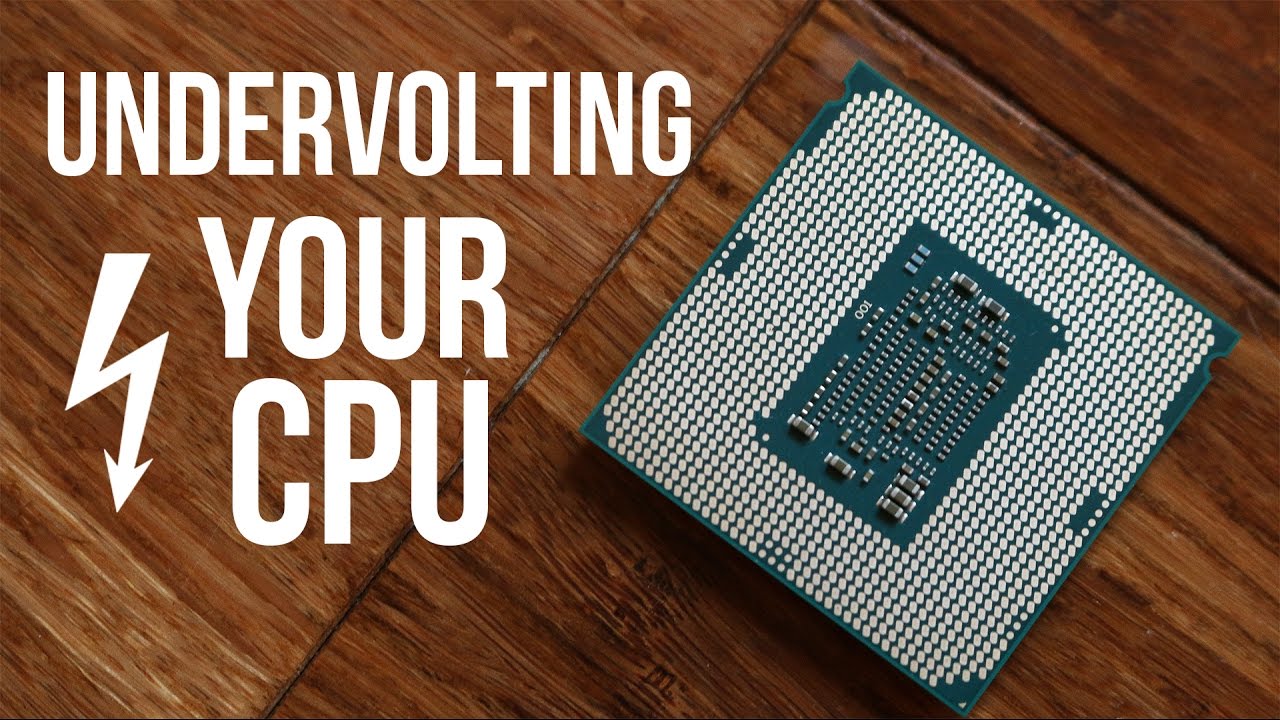Introduction
Welcome to the world of CPU undervolting! If you’re a laptop user looking to optimize the performance of your CPU and enhance its efficiency, then undervolting might just be the solution you’re looking for. In this article, we will explore the concept of CPU undervolting, its benefits, and provide you with a step-by-step guide on how to undervolt your CPU on a laptop.
Before we delve into the process, let’s understand what exactly CPU undervolting is. In simple terms, undervolting involves reducing the amount of voltage supplied to your CPU. Most CPUs are factory-set to operate at a higher voltage than necessary, which results in increased power consumption and heat generation. Undervolting allows you to lower the voltage while maintaining stable performance, which ultimately leads to lower temperatures and increased battery life.
Now, you might be wondering, why bother with undervolting? Well, there are several compelling benefits that make it worth considering. Firstly, undervolting can significantly reduce the temperature of your CPU. Cooler temperatures not only prolong the lifespan of your CPU, but they also help prevent thermal throttling and maintain consistent performance, especially during intensive tasks such as gaming or video editing.
Secondly, undervolting can help extend the battery life of your laptop. By reducing the power consumption of the CPU, your laptop can operate more efficiently, allowing you to enjoy longer periods of usage before needing to plug in and recharge.
Additionally, undervolting can also have a positive impact on the overall system stability. By optimizing voltage levels, you can minimize the chances of CPU crashes, freeze-ups, and other stability issues. It’s important to note that undervolting does not void your warranty, as it is a purely software-based modification that can be easily reverted if needed.
Now that you understand the benefits of CPU undervolting, let’s move on to the prerequisites you’ll need to get started. Don’t worry, it’s nothing too technical! All you’ll need is a compatible laptop with an Intel CPU and a few software tools that we will discuss in the upcoming sections.
What is CPU undervolting?
CPU undervolting is the process of reducing the voltage supplied to the central processing unit (CPU) of a computer or laptop. The voltage supplied to the CPU is responsible for determining its operating frequency and power consumption. By lowering the voltage, you can achieve several benefits, including decreased heat generation, improved energy efficiency, and potentially increased CPU lifespan.
Undervolting is based on the principle that many CPUs are designed to operate at a higher voltage than is actually necessary for stable performance. This higher voltage is set by default to ensure that the CPU can handle a wide range of operating conditions, but it can often be reduced without impacting performance or stability.
When the voltage supplied to a CPU is higher than necessary, it leads to excess power consumption and heat generation. This excess heat can be a cause for concern, especially in laptops, where efficient cooling is crucial. Undervolting allows you to lower the amount of voltage supplied to the CPU, resulting in reduced power consumption and heat output.
Undervolting is not the same as underclocking, which involves reducing the frequency at which the CPU operates. While underclocking can also reduce power consumption and heat generation, it directly affects the performance of the CPU. Undervolting, on the other hand, can achieve power savings and temperature reduction without impacting the CPU’s performance.
One important thing to note is that undervolting should be done carefully and methodically. Each individual CPU has a specific undervolt range that it can tolerate while maintaining stable operation. Undervolting beyond this range can lead to system instability, crashes, or even permanent damage to the CPU.
It is recommended to research and find the safe undervolt range for your specific CPU model before proceeding with the undervolting process. This information can often be found in online forums, manufacturer websites, or by consulting with experienced users who have successfully undervolted the same CPU model.
Now that you have a clear understanding of what CPU undervolting is and the potential benefits it offers, let’s move on to the necessary prerequisites to get started with undervolting your laptop’s CPU.
Benefits of CPU Undervolting
Undervolting your CPU can bring several significant benefits to your laptop’s performance, temperature levels, and battery life. Let’s dive into the key advantages of CPU undervolting:
- Reduced Heat Generation: One of the primary benefits of CPU undervolting is the reduction in heat generation. By supplying a lower voltage to the CPU, you can decrease the amount of heat produced during operation. This can help prevent overheating and improve the overall stability and longevity of your laptop.
- Improved Energy Efficiency: Undervolting allows your CPU to operate at a lower power consumption level while maintaining stable performance. This can result in improved energy efficiency, leading to longer battery life for your laptop. Whether you’re working on the go or gaming for longer periods, undervolting can help extend the time between charges.
- Enhanced Performance under Heavy Loads: By reducing heat generation through undervolting, your CPU is less likely to encounter thermal throttling. Thermal throttling is a mechanism that reduces CPU performance to prevent it from overheating. Undervolting can help mitigate this issue, ensuring that your CPU operates at its full potential even during demanding tasks, such as gaming or video editing.
- No Risk to Hardware: Unlike overclocking, which carries the risk of pushing your CPU beyond its limits, undervolting is generally considered a safe practice. When done within the recommended voltage range, undervolting poses no risk to your hardware. It’s a software-level modification that can be easily reversed if needed, and it does not void your warranty.
- Quieter Operation: As undervolting reduces the heat generated by your CPU, it can also lead to quieter operation. When the CPU runs cooler, the cooling fans don’t need to work as hard, resulting in a quieter overall system. This can be particularly beneficial for those who prefer a quieter computing experience or who use their laptops in noise-sensitive environments.
These are just a few of the key benefits of CPU undervolting. It’s important to note that the extent of these advantages may vary depending on your specific hardware configuration and usage patterns. However, in most cases, undervolting presents an effective and safe method for optimizing your CPU’s performance and efficiency.
Now that you understand the benefits of CPU undervolting, let’s proceed to the prerequisites you need to fulfill before embarking on the undervolting process.
Prerequisites for CPU Undervolting
In order to successfully undervolt your CPU, there are a few prerequisites that you need to fulfill. These prerequisites ensure that you have the necessary tools and knowledge to safely carry out the undervolting process. Let’s take a look at what you’ll need:
- Compatible Laptop: First and foremost, you’ll need a laptop with a supported CPU for undervolting. Most modern laptops with Intel CPUs are compatible with undervolting, as Intel provides software tools for this purpose. It’s essential to check if your specific laptop model and CPU support undervolting.
- Intel CPU: Undervolting is primarily available for Intel CPUs. If you have a laptop with an AMD CPU, the undervolting process may be different, and specific software tools may not be available. Make sure you have an Intel CPU for a smooth undervolting experience.
- Software Tools: To undervolt your CPU, you’ll need to download and install the appropriate software tools. The most commonly used tool for undervolting Intel CPUs is the Intel Extreme Tuning Utility (XTU). It provides a user-friendly interface to adjust voltage settings and monitor CPU performance. Ensure that you have the latest version of the software downloaded from the official Intel website.
- Understanding Safe Undervolt Range: Each CPU model has a unique safe undervolt range where it can operate without stability issues. It’s crucial to research and understand this range specific to your CPU model before attempting to undervolt. Online forums, manufacturer websites, and user experiences can provide valuable insights into finding the optimal undervolt settings for your CPU.
- Patience and Testing: Undervolting is a process that requires patience and testing. It’s essential to take a gradual approach and carefully monitor the stability and performance of your CPU as you make voltage adjustments. Stress testing the undervolted CPU using benchmarking tools helps ensure stability under heavy loads.
By fulfilling these prerequisites, you’ll be well-prepared to undervolt your CPU effectively. It’s important to note that undervolting is a process that should be carried out with caution and an understanding of your specific hardware. With the right tools and knowledge, you can optimize your CPU’s performance, reduce heat generation, and improve energy efficiency.
Now that you have the necessary prerequisites in place, let’s move on to the step-by-step guide on how to undervolt your CPU using the Intel Extreme Tuning Utility.
Step 1: Gathering Necessary Tools
Before you begin the undervolting process, you need to gather the necessary tools that will enable you to successfully undervolt your CPU. Here are the essential tools you’ll need:
- Intel Extreme Tuning Utility (XTU): The Intel Extreme Tuning Utility is the primary software tool you’ll use to undervolt your CPU. It provides a user-friendly interface that allows you to adjust voltage settings and monitor your CPU’s performance. Visit the official Intel website to download the latest version of XTU and ensure compatibility with your CPU model.
- Intel CPU: Undervolting is specific to Intel CPUs. Ensure that you have a laptop with an Intel CPU for the undervolting process. If you have an AMD CPU, the process may differ, and specific software tools for undervolting may not be available.
- Internet Connection: Having a stable internet connection is necessary for downloading the Intel Extreme Tuning Utility and accessing relevant resources, such as CPU undervolt ranges specific to your CPU model.
- Optional: Stress Testing Software: While not mandatory, having stress testing software can be beneficial to ensure the stability of your undervolted CPU. Tools such as Prime95 or AIDA64 can stress your CPU and allow you to monitor its performance and temperature under heavy loads.
Once you have gathered these necessary tools, you are ready to move on to the next step: researching the safe undervolt range for your specific CPU model. This research will help you determine the optimal voltage settings for undervolting your CPU without sacrificing stability or performance.
Now that you have the required tools at your disposal, let’s proceed to the next step: researching the safe undervolt range for your CPU model.
Step 2: Researching the Safe Undervolt Range for Your CPU
Before you start undervolting your CPU, it’s important to research the safe undervolt range specific to your CPU model. Each CPU has its own limitations and requirements when it comes to voltage adjustments. By understanding the safe undervolt range, you can ensure that your CPU remains stable and performs optimally throughout the undervolting process.
To begin your research, consider the following sources:
- Manufacturer Documentation: Visit the official website of your CPU’s manufacturer, such as Intel, to find documentation related to undervolting. Manufacturers often provide guidelines or recommendations regarding undervolt ranges for their CPUs.
- Online Forums and Communities: Participate in online forums and communities dedicated to CPU undervolting. These platforms are filled with experienced users who have already undervolted various CPU models and can provide valuable insights and recommendations for safe undervolt ranges.
- User Solutions: Search for case studies or success stories from users who have undervolted the same CPU model as yours. Their experiences can serve as a reference point and give you an idea of a safe starting point for your undervolting journey.
Keep in mind that the safe undervolt range can vary between different CPU models and even within the same model due to manufacturing variances. It’s crucial to find the range that works best for your specific CPU.
When researching the safe undervolt range, take note of the offset values at which other users have achieved stability and satisfactory results. These values can serve as a starting point for your own undervolting process. However, remember that every CPU is unique, and experimentation may still be necessary to find the optimal undervolt settings for your specific CPU.
By thoroughly researching the safe undervolt range for your CPU, you’ll be equipped with the knowledge needed to proceed confidently to the next step: installing the Intel Extreme Tuning Utility (XTU).
Now that you understand the importance of researching the safe undervolt range, let’s move on to the next step: installing the Intel Extreme Tuning Utility (XTU).
Step 3: Installing Intel Extreme Tuning Utility (XTU)
Now that you have researched the safe undervolt range for your CPU, it’s time to install the necessary software tool to undervolt your CPU: Intel Extreme Tuning Utility (XTU). XTU is a user-friendly software provided by Intel that allows you to make voltage adjustments and monitor your CPU’s performance. Follow these steps to install XTU:
- Check Compatibility: Before downloading XTU, ensure that your CPU is compatible with the utility. Visit the official Intel website and check the list of supported CPUs to ensure compatibility.
- Download XTU: Once you have verified compatibility, navigate to the Intel XTU download page. Download the latest version of XTU that is compatible with your operating system.
- Run the Installer: Locate the downloaded XTU installer file and run it. Follow the on-screen instructions to install the software on your laptop.
- Complete the Installation: Once the installation process is complete, launch XTU to begin configuring your CPU’s voltage settings.
Intel XTU provides an intuitive interface that allows you to adjust various parameters, including voltage settings, turbo boost ratios, and temperature thresholds. However, for the purpose of undervolting, we will primarily focus on adjusting the CPU voltage.
It’s important to note that XTU may require administrative privileges to function optimally, so ensure that you have the necessary permissions on your laptop.
With XTU successfully installed on your laptop, you are now prepared to proceed to the next step: testing the initial undervolt settings to ensure stability and functionality.
Now that you have installed Intel Extreme Tuning Utility (XTU), let’s move on to Step 4: testing the initial undervolt settings on your CPU.
Step 4: Testing the Initial Undervolt Settings
Now that you have installed the Intel Extreme Tuning Utility (XTU) and are ready to begin undervolting your CPU, it’s time to test the initial undervolt settings. Testing allows you to ensure the stability and functionality of your undervolted CPU before making further adjustments. Follow these steps to test the initial undervolt settings:
- Launch Intel XTU: Open the Intel Extreme Tuning Utility (XTU) on your laptop. You should see a user-friendly interface with various tabs and settings.
- Adjust Voltage Offset: Navigate to the “Core Voltage Offset” or similar setting within XTU. This setting allows you to make voltage adjustments to your CPU. Start by applying a conservative undervolt of around -50 mV (millivolts) to your CPU. This value may vary depending on your CPU model and the safe undervolt range you found during your research.
- Apply the Changes: After adjusting the voltage offset, click on the “Apply” or “Save” button within XTU to implement the changes. The new voltage offset will be applied to your CPU, and you can observe the impact on its performance and temperature.
- Monitor Stability and Temperature: Use XTU’s monitoring features to observe the CPU’s stability and temperature while performing various tasks. Monitor the CPU’s performance under both idle and load conditions and keep an eye on any signs of system instability, such as crashes or freezes. Additionally, keep track of the CPU temperature to ensure it remains within safe limits.
- Run Stress Tests: To further test the stability of your undervolted CPU, consider running stress tests using benchmarking software such as Prime95 or AIDA64. These stress tests put your CPU under heavy load to simulate demanding usage scenarios. Monitor the system during stress tests to ensure stability and temperature are within acceptable ranges.
- Assess Results: Based on the stability and temperature observations, determine whether the initial undervolt settings are successful. If the CPU remains stable and temperatures are significantly lower compared to the stock voltage settings, proceed to the next step. If instability or abnormal temperatures occur, revert to the default voltage settings and revisit the safe undervolt range research to make adjustments.
Testing the initial undervolt settings allows you to gauge the impact of the voltage adjustments on your CPU’s stability and temperature. Remember that undervolting is a trial-and-error process, and further adjustments may be necessary to achieve the optimal balance between performance, stability, and temperature reduction.
With the initial undervolt settings successfully tested, it’s time to fine-tune the undervolt settings in Step 5.
Step 5: Fine-tuning the Undervolt Settings
After testing the initial undervolt settings and ensuring the stability and functionality of your CPU, it’s time to fine-tune the undervolt settings for optimal performance. Fine-tuning allows you to make precise adjustments to the voltage offset, further optimizing your CPU’s efficiency and temperature levels. Follow these steps to fine-tune the undervolt settings:
- Gradual Voltage Adjustments: Start by making small adjustments to the voltage offset. It’s recommended to make changes in increments of around -5 mV to -10 mV to ensure gradual and controlled adjustments.
- Apply and Test: After each voltage adjustment, apply the changes in the Intel Extreme Tuning Utility (XTU) and then test your CPU’s stability and temperature. Monitor the system during normal usage and, if possible, run stress tests to determine the impact of each adjustment.
- Observe Performance and Temperature: Pay close attention to the CPU’s performance and temperature while testing each fine-tuned voltage setting. Look for any signs of instability, such as system crashes or freezes. Additionally, monitor the CPU temperature to ensure it remains within safe operating limits.
- Iterative Process: Fine-tuning undervolt settings is an iterative process. Repeat the adjustment, application, and testing steps multiple times to find the optimal balance for your CPU. It may take several iterations and adjustments to achieve the best combination of stability, performance, and temperature reduction.
- Document Changes: Keep track of the adjustments you make during the fine-tuning process. Document the voltage offset values for each adjustment, along with the corresponding CPU performance and temperature observations. This documentation will help you keep a record of the changes and their impact on your CPU’s performance.
- Monitor Long-term Stability: After settling on a fine-tuned undervolt setting, continue to monitor the long-term stability of your CPU. Test it under various usage scenarios and keep an eye on its performance and temperature over an extended period of time. This will ensure that the undervolted settings remain stable and deliver the desired results in the long run.
Fine-tuning the undervolt settings requires patience and careful observation. By making gradual adjustments, testing the stability and temperature, and recording the changes, you can optimize your CPU’s efficiency and effectively reduce heat generation.
Now that you have fine-tuned the undervolt settings, it’s time to move on to the next step: stress testing the undervolted CPU to ensure maximum stability and reliability.
Step 6: Stress Testing the Undervolted CPU
Once you have fine-tuned the undervolt settings for your CPU, it’s crucial to stress test the undervolted CPU to ensure maximum stability and reliability. Stress testing allows you to evaluate the performance of the CPU under heavy loads and verify that the undervolted settings can withstand demanding usage scenarios without encountering instability or overheating. Follow these steps to stress test your undervolted CPU:
- Choose a Benchmarking Tool: Select a reliable benchmarking tool that is suitable for stress testing your CPU. Popular options include Prime95, AIDA64, and Intel Burn Test. These tools will put your CPU under heavy load and push it to its limits.
- Configure Stress Test Settings: Configure the stress test settings within the chosen benchmarking tool. Typically, you can adjust the duration and intensity of the stress test. It’s recommended to run the stress test for an extended period, such as 1-2 hours, to ensure thorough testing of stability and temperature levels.
- Monitor CPU Performance and Temperature: Observe the CPU’s performance and temperature during the stress test. Monitor the system in real-time using monitoring software provided by XTU or the benchmarking tool. Ensure that the CPU remains stable and that the temperatures stay within safe limits. If you encounter any signs of instability or excessively high temperatures, stop the stress test immediately.
- Assess Stability and Reliability: Based on the stress test results, assess the stability and reliability of your undervolted CPU. If the CPU remains stable throughout the stress test and the temperatures are well within acceptable ranges, it indicates that the undervolt settings are successful and can be considered reliable.
- Iterative Adjustments (if necessary): If you encounter instability or excessively high temperatures during the stress test, it may be necessary to make further adjustments to the undervolt settings. Gradually increase the voltage offset in small increments, repeating the stress testing process after each adjustment, until you achieve stable and reliable performance.
Stress testing the undervolted CPU is a crucial step to confirm the stability and reliability of the undervolt settings. It allows you to ensure that your CPU can handle demanding usage scenarios without encountering stability issues or thermal throttling.
With the undervolted CPU successfully stress tested, it’s time to move on to the final step: monitoring and adjusting the undervolt settings as needed.
Step 7: Monitoring and Adjusting as Needed
After completing the stress testing of your undervolted CPU, it’s important to continuously monitor and make adjustments as needed. Monitoring and adjusting allow you to ensure that your CPU remains stable, performs optimally, and maintains safe temperature levels over time. Follow these steps for effective monitoring and adjusting:
- Use Monitoring Tools: Make use of monitoring tools provided by the Intel Extreme Tuning Utility (XTU) or other third-party software to regularly monitor your CPU’s performance and temperature. Keep an eye on temperature fluctuations and performance variations to ensure that the undervolt settings continue to deliver the desired results.
- Observe Temperature Levels: Pay close attention to the CPU temperature during both idle and load conditions. Ensure that the temperature remains within safe limits and doesn’t reach critical levels that could potentially cause thermal throttling or damage to the CPU.
- Monitor Stability: Keep an eye on the stability of your undervolted CPU over time. Watch out for any system crashes, freezes, or other signs of instability. If you encounter stability issues, consider dialing back the undervolt settings slightly to restore stability while still maintaining improved efficiency and temperature reduction.
- Record and Analyze Data: Maintain a record of the performance and temperature data obtained through monitoring. Document any significant changes or patterns that you observe. This data can help you identify trends and make informed decisions about adjustments if needed.
- Adjust as Necessary: If you notice any issues, such as increased instability or higher temperatures than desired, make adjustments to the undervolt settings accordingly. Gradually increase or decrease the voltage offset in small increments and repeat the monitoring process to observe the impact of the adjustments. This iterative process allows you to fine-tune the undervolt settings for optimal performance and efficiency.
Remember that monitoring and adjusting the undervolt settings is an ongoing process. As your computing needs change or as your laptop experiences different usage scenarios, you may need to revisit and make adjustments to the undervolt settings to ensure optimal performance and stability.
By following these monitoring and adjusting practices, you can maintain the benefits of CPU undervolting, such as improved efficiency, reduced heat generation, and potential energy savings, while ensuring the long-term stability and reliability of your undervolted CPU.
With this final step, you have completed the process of undervolting your CPU successfully! Enjoy the enhanced performance and efficiency of your undervolted laptop.
Conclusion
CPU undervolting is a powerful technique that allows you to optimize the performance and efficiency of your laptop’s CPU. By reducing the voltage supplied to the CPU, you can lower power consumption, decrease heat generation, and potentially extend battery life. Throughout this step-by-step guide, we have explored the process of CPU undervolting, from understanding the concept to fine-tuning the undervolt settings.
We began by introducing CPU undervolting and its benefits, highlighting how it can reduce heat, improve energy efficiency, and enhance system stability. We then discussed the prerequisites, including having a compatible laptop with an Intel CPU and downloading the necessary software tools like Intel Extreme Tuning Utility (XTU).
Next, we walked through each step of the undervolting process. We covered researching the safe undervolt range specific to your CPU model, installing XTU, testing the initial undervolt settings, and fine-tuning the undervolt settings for optimal performance and stability. Stress testing the undervolted CPU was emphasized to ensure maximum stability and reliability, followed by the importance of monitoring and adjusting the undervolt settings as needed for long-term performance.
Undervolting is a continuous process, and it is crucial to monitor your CPU’s performance and temperature regularly. By doing so, you can identify any issues and make adjustments to maintain the optimal balance of stability, efficiency, and temperature reduction.
Remember, CPU undervolting is a software-based modification that does not void your warranty and can be easily reversed if needed. However, it’s important to proceed with caution, conduct thorough research, and make gradual adjustments to avoid instability or damage to your CPU.
Undervolting your CPU can result in a cooler and more efficient laptop, extending its lifespan and improving the user experience. Enjoy the benefits of longer battery life, quieter operation, and enhanced thermal performance as you optimize your CPU’s power consumption.
We hope that this guide has provided you with the knowledge and confidence to embark on the CPU undervolting journey. Harness the power of undervolting and unlock the full potential of your laptop’s CPU for an enhanced computing experience.

























